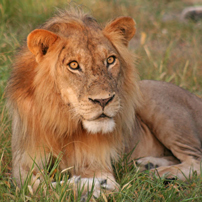 Can you get too close to Africa’s dangerous wildlife?
Can you get too close to Africa’s dangerous wildlife?
On a recent trip to Botswana I enjoyed two wonderful wildlife encounters that had me almost within touching distance of two of Africa’s iconic species – elephant and leopard. One sighting, the elephant, was, in my book, not uncommon, but the leopard experience was a first and it did make me think!
We were the only vehicle at a sighting where a leopard was asleep in the grass as the afternoon sun started to lose strength. 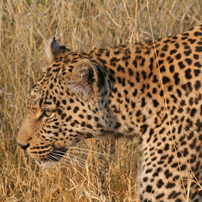 Although we were fairly close, the leopard was very relaxed and we had stayed because the leopard was showing signs of becoming active, yawning and stretching. We wondered whether he would sit up to be photographed whilst the light was still good. Then suddenly, after one of his stretching sessions, the leopard came boldly over to investigate the vehicle, approaching to within a foot or so and seemingly peering underneath. I was sitting behind the driver in the open vehicle and could have reached my foot out and touched the leopard’s head as it stared straight at me before diverting its gaze to seemingly follow the outline of the vehicle as if looking for a perch. After a rather intense minute or two, the leopard retreated a few metres and sat down, grunting forcibly as he did so. Exciting as it was, it was just a little too close for my comfort!
Although we were fairly close, the leopard was very relaxed and we had stayed because the leopard was showing signs of becoming active, yawning and stretching. We wondered whether he would sit up to be photographed whilst the light was still good. Then suddenly, after one of his stretching sessions, the leopard came boldly over to investigate the vehicle, approaching to within a foot or so and seemingly peering underneath. I was sitting behind the driver in the open vehicle and could have reached my foot out and touched the leopard’s head as it stared straight at me before diverting its gaze to seemingly follow the outline of the vehicle as if looking for a perch. After a rather intense minute or two, the leopard retreated a few metres and sat down, grunting forcibly as he did so. Exciting as it was, it was just a little too close for my comfort!
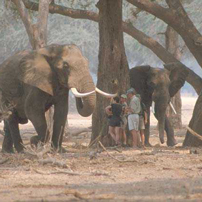 The following morning I was having breakfast in a small bush camp when three male elephants wandered into camp, two of them passed us by, but one seemed to have chosen a route that came right past our relatively flimsy mess tent. Having collected some fallen pods from a nearby tree, he strolled directly towards us, suddenly looking rather huge! He stopped about 5 yards away from us and had a good look, and then ambled right past the corner of the tent just a few yards from our table. Despite the elephant’s size, this was a very relaxed experience – the elephant was clearly comfortable with the presence of the camp, and our presence at the breakfast table.
The following morning I was having breakfast in a small bush camp when three male elephants wandered into camp, two of them passed us by, but one seemed to have chosen a route that came right past our relatively flimsy mess tent. Having collected some fallen pods from a nearby tree, he strolled directly towards us, suddenly looking rather huge! He stopped about 5 yards away from us and had a good look, and then ambled right past the corner of the tent just a few yards from our table. Despite the elephant’s size, this was a very relaxed experience – the elephant was clearly comfortable with the presence of the camp, and our presence at the breakfast table.
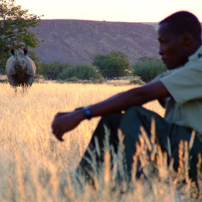 These experiences made me think of other such encounters over the years, of which there have been many. Some are wonderful if not entirely natural – such as cheetah which use vehicles as vantage points in the Masai Mara and actually climb onto the roofs, or lions or leopards that have used a slowly moving vehicle to screen its approach from prey – very inventive by the animal, but one which leaves you feeling like your presence is ‘interfering’ with, rather than been part of, the natural world. Others are less fun, such as a hippo surfacing just behind your canoe or a buffalo bull emerging from a thicket on a walking safari. The closest I have ever been to a wild rhino was in Zimbabwe in the late nineties, where a rhino called Chewore, which had been raised initially in an orphanage and then released back into the wild, had a fondness for us two-legged creatures. Her familiarity however turned to frustration when we wouldn’t stay and play with her. She charged us several times, though arguably never with the intent to hurt, but to this day I can remember the feeling of trying to hide behind an 10 inch wide mopane tree………it was a struggle even back then!
These experiences made me think of other such encounters over the years, of which there have been many. Some are wonderful if not entirely natural – such as cheetah which use vehicles as vantage points in the Masai Mara and actually climb onto the roofs, or lions or leopards that have used a slowly moving vehicle to screen its approach from prey – very inventive by the animal, but one which leaves you feeling like your presence is ‘interfering’ with, rather than been part of, the natural world. Others are less fun, such as a hippo surfacing just behind your canoe or a buffalo bull emerging from a thicket on a walking safari. The closest I have ever been to a wild rhino was in Zimbabwe in the late nineties, where a rhino called Chewore, which had been raised initially in an orphanage and then released back into the wild, had a fondness for us two-legged creatures. Her familiarity however turned to frustration when we wouldn’t stay and play with her. She charged us several times, though arguably never with the intent to hurt, but to this day I can remember the feeling of trying to hide behind an 10 inch wide mopane tree………it was a struggle even back then!
Dangerous experiences are however extremely rare compared to the wonderful up close encounters that are widely available throughout safari Africa.
 In the forests of central Africa, it is possible to enjoy one of Africa’s most amazing experiences – meeting the great apes in their natural habitat. Gorillas are the largest primate in Africa, and a fully grown silverback will set the blood pumping if he so much as looks at you. You are supposed to always stay at least 7 metres from them, but in reality the gorillas do not understand the rules and often move closer to you, sometimes leaving you with no ‘retreat’ options. However, gorillas are essentially peaceful herbivores and as long as you remain calm and still (and overt your eyes if needed – intent gazing is threatening behaviour to them), you are in very little danger.
In the forests of central Africa, it is possible to enjoy one of Africa’s most amazing experiences – meeting the great apes in their natural habitat. Gorillas are the largest primate in Africa, and a fully grown silverback will set the blood pumping if he so much as looks at you. You are supposed to always stay at least 7 metres from them, but in reality the gorillas do not understand the rules and often move closer to you, sometimes leaving you with no ‘retreat’ options. However, gorillas are essentially peaceful herbivores and as long as you remain calm and still (and overt your eyes if needed – intent gazing is threatening behaviour to them), you are in very little danger.
Chimpanzees are not considered as iconic as gorillas, but perhaps they should be. They are generally more active and where they have been fully habituated to human presence you can get really close as you watch them go about their lives in the forest. A few years ago in Mahale Mountains National Park in western Tanzania, I was lucky enough to have a large family of chimps claim ‘right of way’ on a jungle path, brushing my legs as they passed by – incredible!
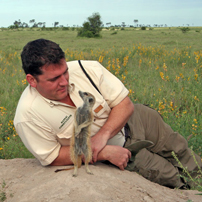 In the desert regions of southern Africa, meerkats are cute and non-threatening, and where they have been habituated to human presence, they allow you to get very close. In Botswana’s Makgadikgadi Pans National Park, the meerkats will even clamber on top of your head and shoulders for a better view over the surrounding landscape!
In the desert regions of southern Africa, meerkats are cute and non-threatening, and where they have been habituated to human presence, they allow you to get very close. In Botswana’s Makgadikgadi Pans National Park, the meerkats will even clamber on top of your head and shoulders for a better view over the surrounding landscape!
Wild dogs may sound like a ferocious predator and indeed they are ruthless when hunting and feeding, but to humans they present no danger at all. In the Mana Pools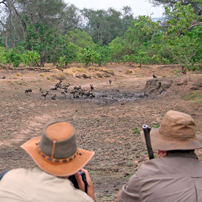 region of Zimbabwe some years ago, certain professional guides began to approach wild dogs on their hands and knees, or even lying flat on the ground. Rather than being scared off, the dogs were intrigued and came closer to investigate, making for some wonderful up close experiences. It is now possible to do this in a few other places – all you need are the dogs themselves (which are never easy to track down!) and a guide who is comfortable leading the activity. Steve Carey of Laikipia Wilderness Camp in Kenya is one such guide outside of Zimbabwe (no surprise as he originally comes from Zimbabwe).
region of Zimbabwe some years ago, certain professional guides began to approach wild dogs on their hands and knees, or even lying flat on the ground. Rather than being scared off, the dogs were intrigued and came closer to investigate, making for some wonderful up close experiences. It is now possible to do this in a few other places – all you need are the dogs themselves (which are never easy to track down!) and a guide who is comfortable leading the activity. Steve Carey of Laikipia Wilderness Camp in Kenya is one such guide outside of Zimbabwe (no surprise as he originally comes from Zimbabwe).
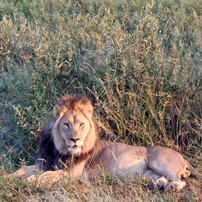 In many parts of Africa, lions have become extremely habituated to the presence of vehicles and will walk right past them, or even use them for shade. It is assumed that lions would never pose a danger to the occupants of a safari vehicle, but there are few people that don’t feel vulnerable when a big lioness or majestic male lion stare at them from a few yards away! Add darkness to the occasion, and lions on the move, and it is even more thrilling to be so close to these awesome creatures. On foot, there is definitely a limit to how close you want to get to lions, and they will usually tell you exactly where that limit is. In Zimbabwe several years ago I was given an expert lesson by a walking guide who walked us into lions. A senior lioness got upset at one stage, but then relaxed completely when we took just one step backwards. The guide drew a line in the sand with the butt of his rifle.
In many parts of Africa, lions have become extremely habituated to the presence of vehicles and will walk right past them, or even use them for shade. It is assumed that lions would never pose a danger to the occupants of a safari vehicle, but there are few people that don’t feel vulnerable when a big lioness or majestic male lion stare at them from a few yards away! Add darkness to the occasion, and lions on the move, and it is even more thrilling to be so close to these awesome creatures. On foot, there is definitely a limit to how close you want to get to lions, and they will usually tell you exactly where that limit is. In Zimbabwe several years ago I was given an expert lesson by a walking guide who walked us into lions. A senior lioness got upset at one stage, but then relaxed completely when we took just one step backwards. The guide drew a line in the sand with the butt of his rifle.
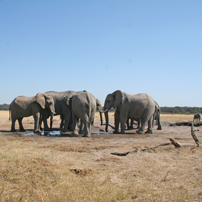 Another way to get up close and personal with Africa’s wild animals is from a ‘hide’. Often overlooking a waterhole where animals need to come and drink, a good hide can have you within metres of totally wild animals, especially elephants. In Zimbabwe’s Hwange National Park, the dry season is harsh and the huge elephant populations survive on pumped waterholes. Viewing upwards of 100 elephants is spectacular even from a vehicle, but a hide offers a completely different and exciting perspective. Hides are common throughout the good safari areas and can be very specific such as in Zambia where there are hides at eye level with hippo pools and carmine bee-eater nesting sites.
Another way to get up close and personal with Africa’s wild animals is from a ‘hide’. Often overlooking a waterhole where animals need to come and drink, a good hide can have you within metres of totally wild animals, especially elephants. In Zimbabwe’s Hwange National Park, the dry season is harsh and the huge elephant populations survive on pumped waterholes. Viewing upwards of 100 elephants is spectacular even from a vehicle, but a hide offers a completely different and exciting perspective. Hides are common throughout the good safari areas and can be very specific such as in Zambia where there are hides at eye level with hippo pools and carmine bee-eater nesting sites.
Sometimes it isn’t necessary to have a hide, you can just sit out in the open and watch wildlife at a waterhole. 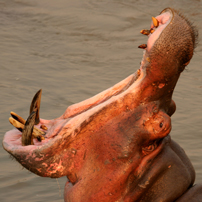 At Kanga Camp in Zimbabwe’s Mana Pools, I watched four different leopards, three honey badgers, a spotted genet, a lonesome spotted hyaena, a porcupine, several herds of elephant and finally a pride of lions all come and drink at the waterhole below our deck whilst we ate dinner. The leopards kept their distance, but the elephants, lions and other species were comfortable very close to our deck. It was the very end of the dry season, and with no other water for miles around, the incentive to drink was obviously very strong! What was most interesting is that the different species were unusually accepting of each other.
At Kanga Camp in Zimbabwe’s Mana Pools, I watched four different leopards, three honey badgers, a spotted genet, a lonesome spotted hyaena, a porcupine, several herds of elephant and finally a pride of lions all come and drink at the waterhole below our deck whilst we ate dinner. The leopards kept their distance, but the elephants, lions and other species were comfortable very close to our deck. It was the very end of the dry season, and with no other water for miles around, the incentive to drink was obviously very strong! What was most interesting is that the different species were unusually accepting of each other.
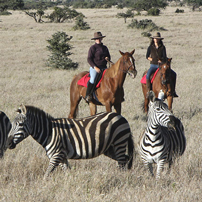 Other activities also allow you to get up close to Africa’s wild animals – boat cruises and canoeing safaris can take you past crocodiles at eye level whilst horse-riding safaris can allow you to canter alongside herds of zebra and giraffe. Walking safaris are not known for specifically getting you close to wildlife, as it is usual for animals to be wary of two-legged mammals, but in the right conditions it is sometimes possible to approach very close to certain animals.
Other activities also allow you to get up close to Africa’s wild animals – boat cruises and canoeing safaris can take you past crocodiles at eye level whilst horse-riding safaris can allow you to canter alongside herds of zebra and giraffe. Walking safaris are not known for specifically getting you close to wildlife, as it is usual for animals to be wary of two-legged mammals, but in the right conditions it is sometimes possible to approach very close to certain animals.
Lastly, this article would not be complete without mentioning Africa’s marine wildlife – whales, sharks, manta rays and the like! The Indian Ocean is wonderful for diving and snorkelling and South Africa is well-known for superb whale-watching and white shark cage diving off the south coast (Southern Right whales – July to November).
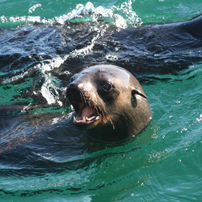 When it comes to getting up close and personal with Africa’s dangerous animals, I don’t think you can beat being six inches away from the tip of a great white shark’s nose!
When it comes to getting up close and personal with Africa’s dangerous animals, I don’t think you can beat being six inches away from the tip of a great white shark’s nose!
As illustrated by above, there are many species of wildlife which are comfortable with the non-threatening presence of humans, and there is no set rule or limit as to how close we should get to them. The key point with all wildlife viewing is to allow the animals to set the rules. They will invariably communicate their feelings, either by moving away, remaining relaxed, coming to investigate or on the odd occasion telling you, in their particular way, to ‘back off’. Good guides in Africa will be able to read animal behaviour and manage sightings accordingly. As long as the animals are relaxed and in control, there is no harm enjoying up close experiences.
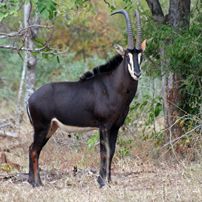 There are also a number of more ‘zoo-like’ experiences where you can get very close to semi-tame or fully tame animals. From riding elephants, feeding giraffes or walking with lions, there are many options. As interesting as these activities may be, they are not true safari experiences.
There are also a number of more ‘zoo-like’ experiences where you can get very close to semi-tame or fully tame animals. From riding elephants, feeding giraffes or walking with lions, there are many options. As interesting as these activities may be, they are not true safari experiences.
